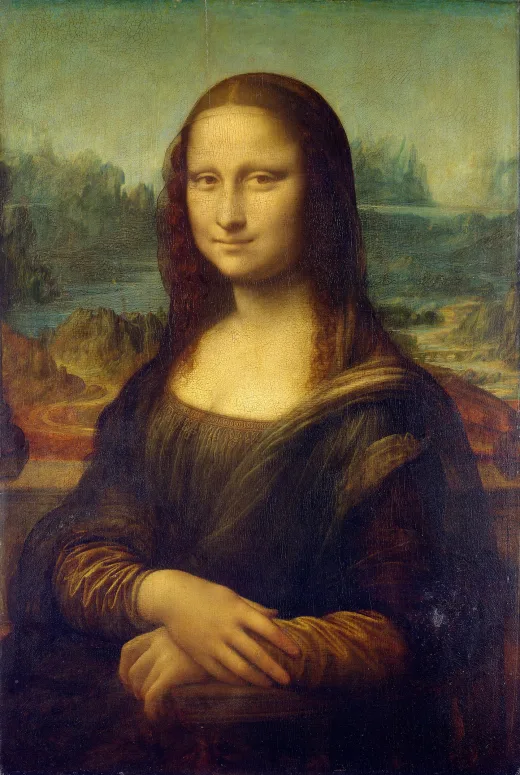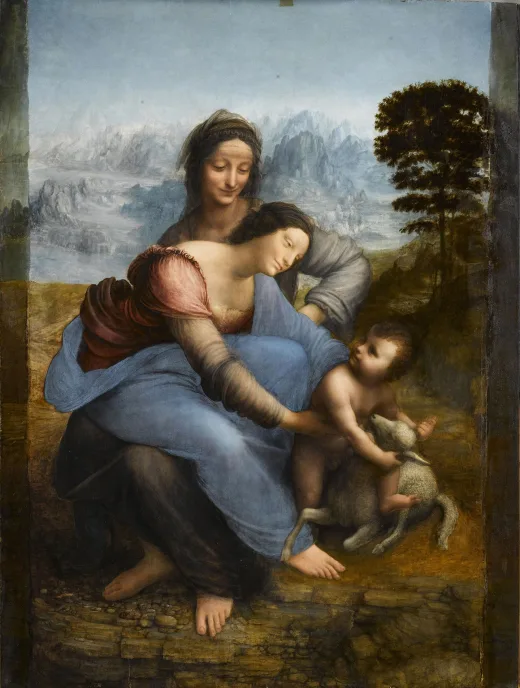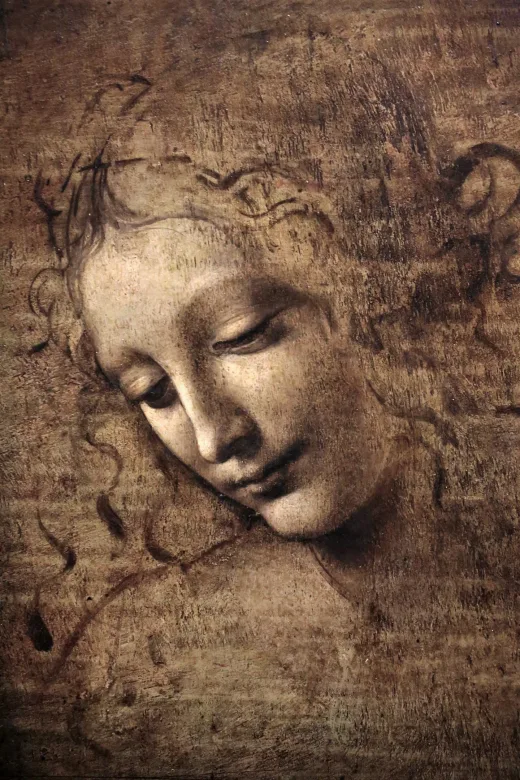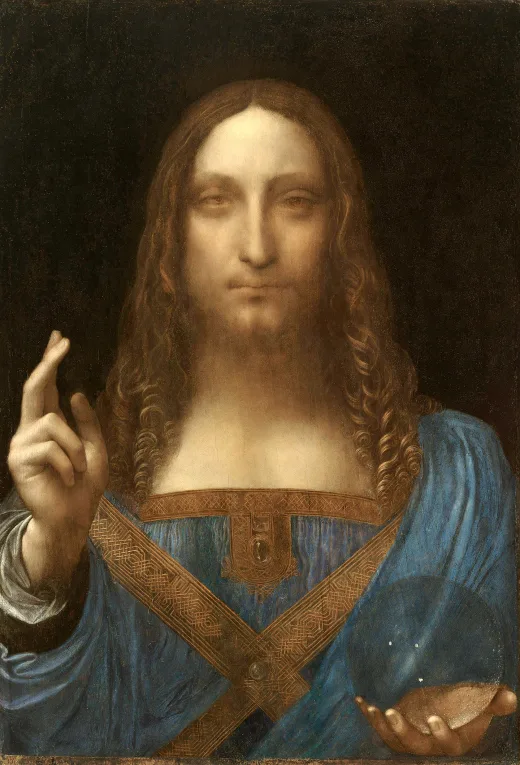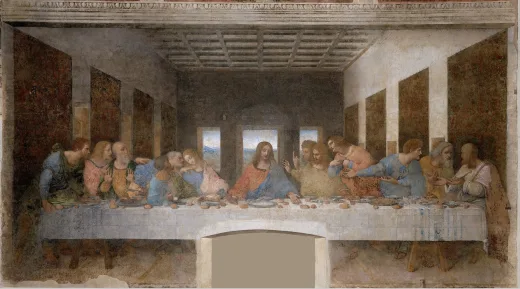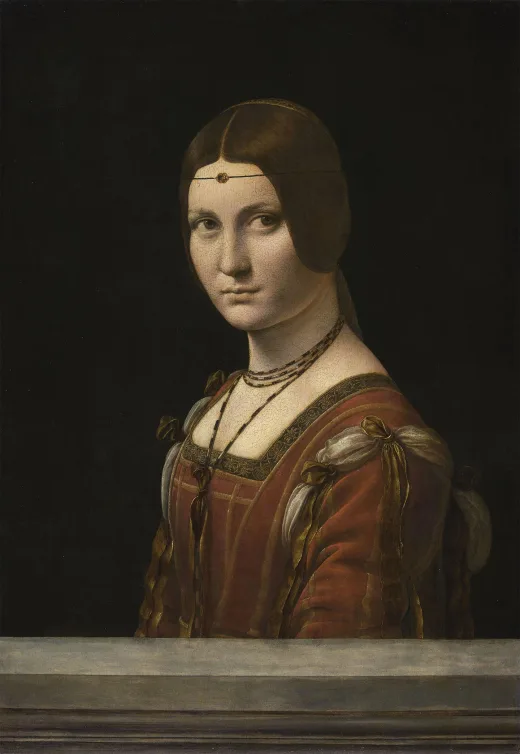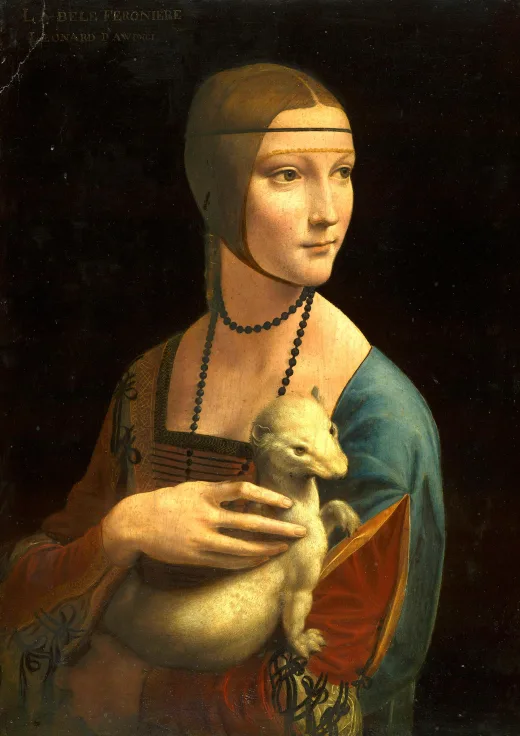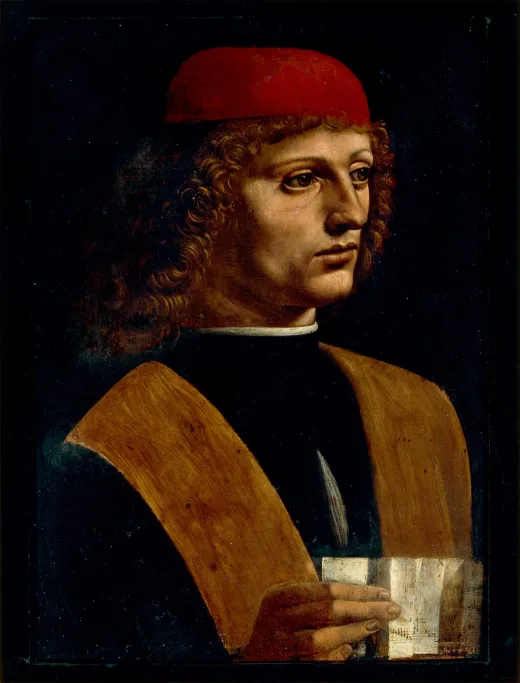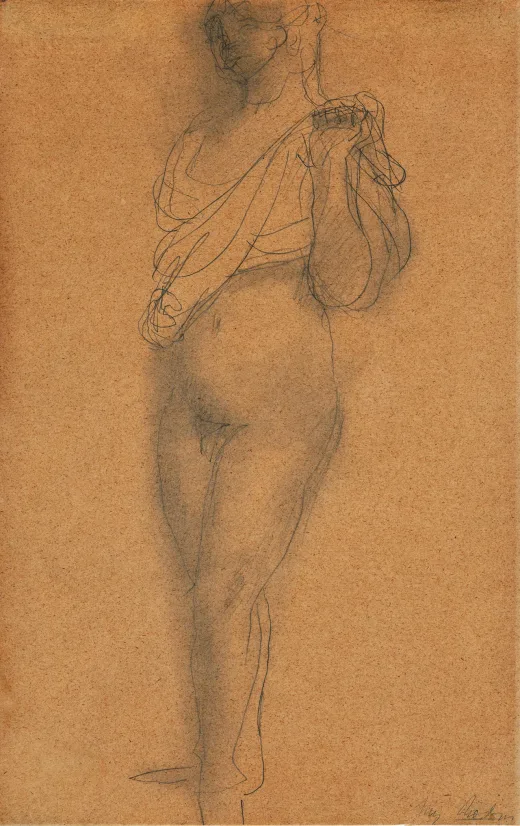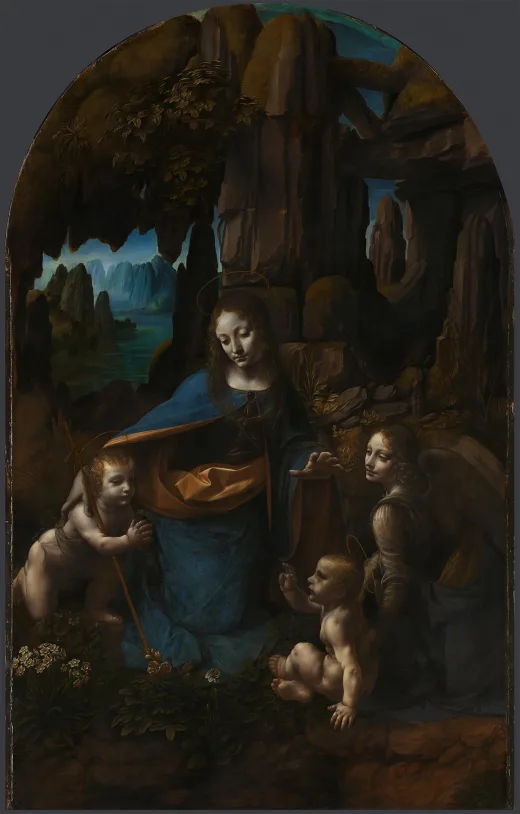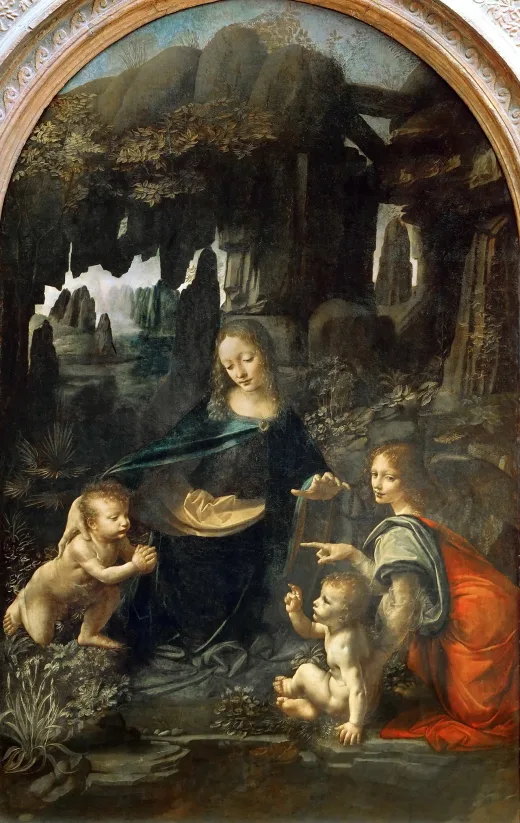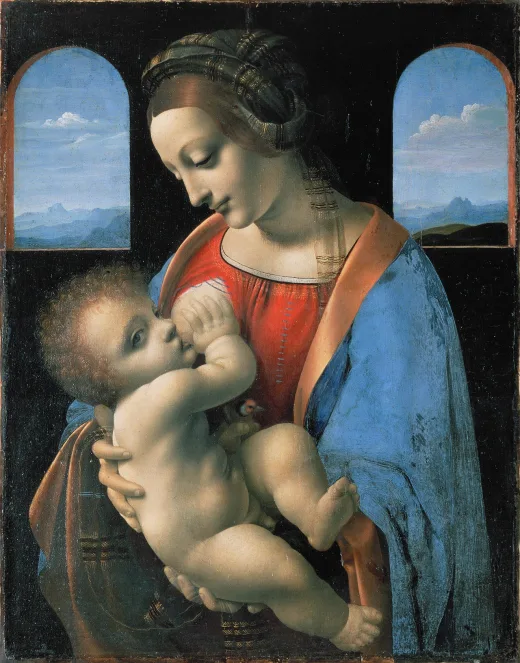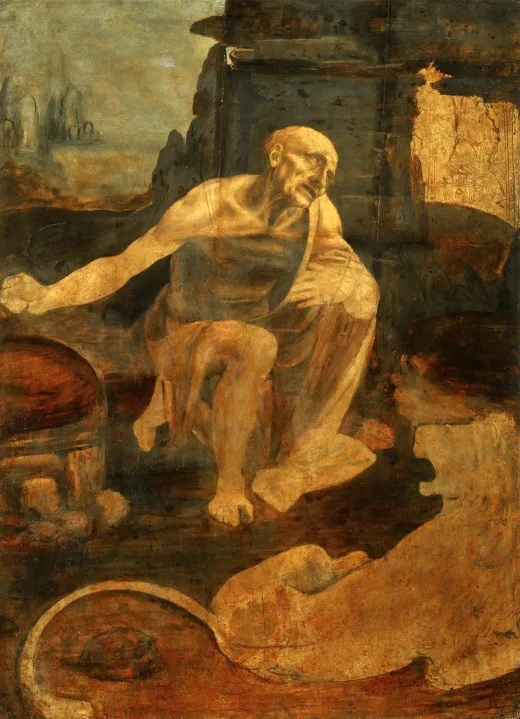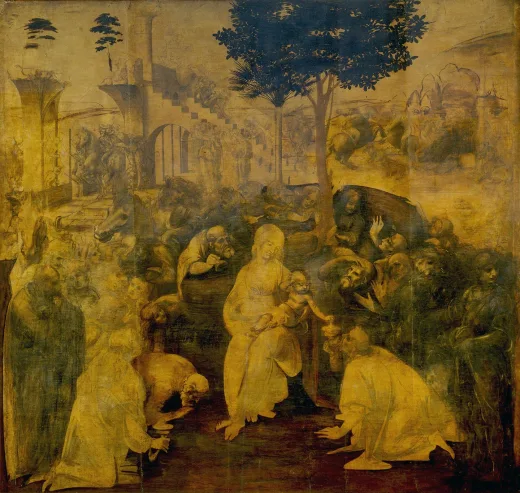达·芬奇素描《圣母子与圣安妮及施洗者圣约翰》高清图片
原图尺寸:4487×6000像素(72 DPI)高清图
下载原图消耗3艺点
文件大小:56.15 MB
下载格式: ZIP ( PNG+JPG )
作品名称:圣母子与圣安妮及施洗者圣约翰
The Virgin and Child with Saint Anne and Saint John the Baptist
作品作者:列奥纳多·达·芬奇(Leonardo da Vinci)
创作时间:约 1499–1500 年或约 1506–1508 年
作品风格:文艺复兴盛期
原作尺寸:141.5 × 104.6 厘米
作品材质:木炭、黑白粉笔、彩色纸、裱于画布
收藏位置:伦敦国家美术馆
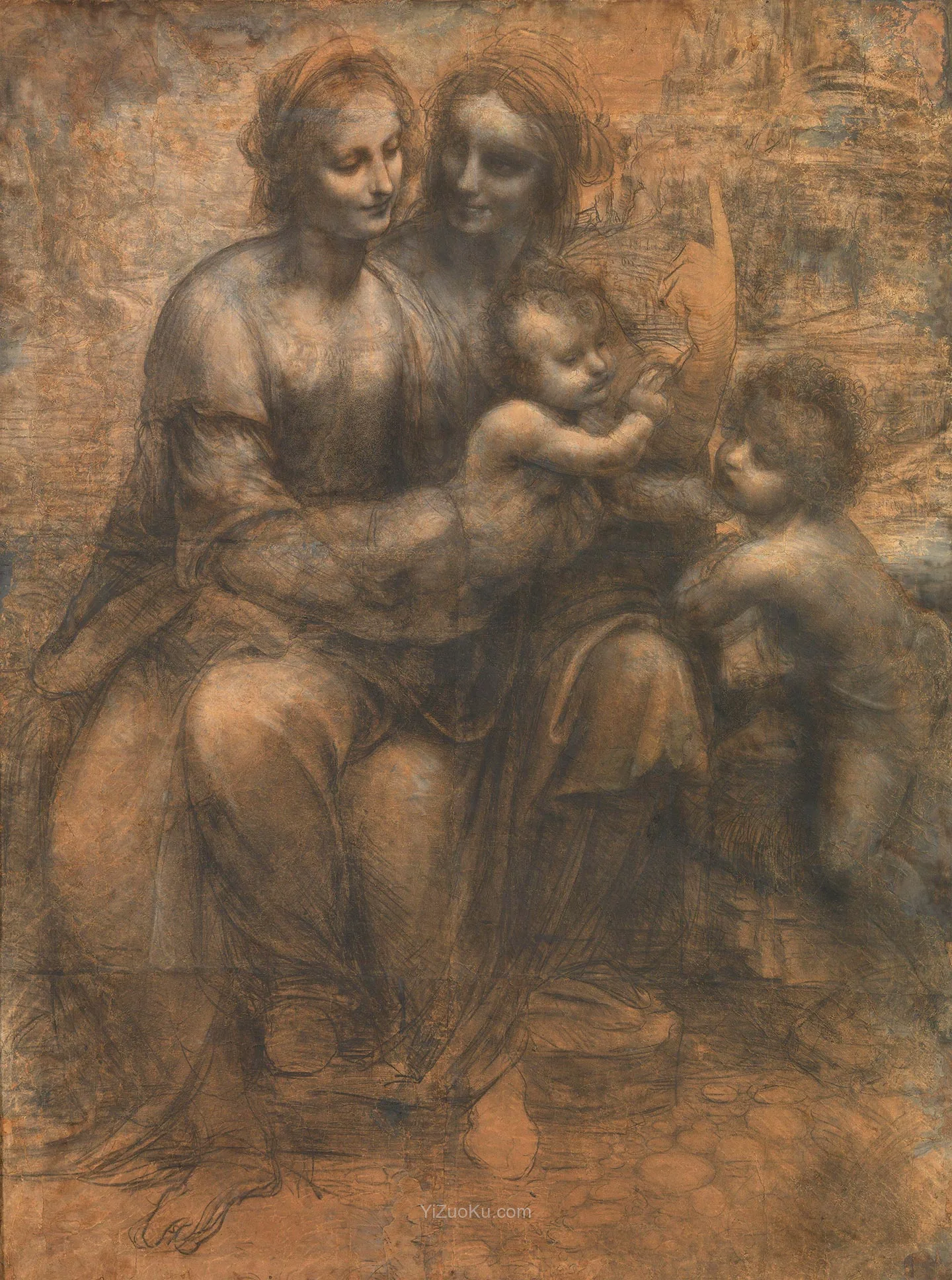
作品简介
《圣母子与圣安妮及施洗者圣约翰》(又称《伯灵顿宫草图》)是列奥纳多·达·芬奇创作的炭笔素描作品,采用黑白粉笔在八张粘合而成的纸上绘制。基于其巨大尺幅(通常规格为41.5×29.6厘米),学界普遍认为这是为油画创作的预备草图。尽管该素描可能是为路易十二委托创作的一幅已失传或未完成的油画所作准备,但现存达·芬奇画作中并无直接基于此草图的成品。此作是艺术家现存唯一的大型素描作品。
素描构图展现圣母玛利亚坐在其母圣安妮膝上怀抱圣婴,而基督的表兄施洗者圣约翰立于右侧。作品现藏于伦敦国家美术馆,创作时间存在争议:一说为1499-1500年(达·芬奇首次米兰时期的尾声),另一说为1506-1508年(艺术家往返佛罗伦萨与米兰期间)。虽多数研究者倾向后者,但国家美术馆等机构支持前者断代。
该作品融合了十五世纪佛罗伦萨绘画两大流行主题:"圣母子与施洗约翰"及"圣母子与圣安妮"。其构图复杂性尤为突出:两位女性的膝盖呈相反方向伸展——圣母双膝向左外侧扭转,而上身急剧右转,形成蜿蜒动势。这种螺旋式动态首次出现于达·芬奇早期作品《柏诺瓦的圣母》,在人物下半身本应通过稳固的足部支撑、舒展的膝盖及宽大袍服营造稳定感的区域,反而形成了强烈的垂直韵律。当她们下半身相背时,两张相似的面庞却彼此呼应,上半身轮廓的模糊处理甚至造成共用一个身体的视觉错觉。
圣母的扭转动态在圣婴身上得到延续——被母亲近乎水平托举的基督身体呈轴向旋转:下半身朝上而上半身朝下。这种扭转姿态首现于《三博士来朝》,并在大英博物馆藏《圣母子与猫》系列习作中反复探索。两组人物的头部并置构成重要构图元素:圣婴的角度、光线与凝视复刻了母亲的特征,而施洗约翰则再现了圣安妮的面部特质。光影处理暗示场景中存在两位主角与两位配角,四人视线交织形成精妙互动:圣安妮以充满敬意的微笑注视女儿,既流露母性骄傲又暗合"万代要称她为有福"的宗教寓意;圣母目光锁定正抬手为表兄赐福的圣婴——这预表了三十年后施洗约翰为基督行洗礼的使命;尽管年长却谦卑领受祝福的施洗约翰,恰如日后所言"我就是给他解鞋带也不配";圣安妮食指指天的神秘手势悬于孩童头顶,昭示祝福的本源——这一典型的"达·芬奇式"手势亦见于《最后的晚餐》与《施洗者圣约翰》。
此类草图通常通过刺孔或刻痕转绘至画板,但本作未见相关痕迹,表明其可能本身就被视为独立艺术品。达·芬奇似乎未直接依此创作油画,其构图与卢浮宫藏同主题作品《圣母子与圣安妮》(未包含施洗约翰形象)存在显著差异。
The Virgin and Child with Saint Anne and Saint John the Baptist, sometimes called the Burlington House Cartoon, is a drawing by Leonardo da Vinci. The drawing is in charcoal and black and white chalk, on eight sheets of paper that are glued together. Because of its large size and format the drawing is presumed to be a cartoon for a painting. No painting by Leonardo exists that is based directly on this cartoon, although the drawing may have been in preparation for a now lost or unexecuted painting commissioned by Louis XII. The drawing is the only extant larger-scale drawing by the artist.
The drawing depicts the Virgin Mary seated on the thigh of her mother, Saint Anne, while holding the Christ Child as Christ's young cousin, John the Baptist, stands to the right. It currently hangs in the National Gallery in London.
It was executed either around 1499–1500, at the end of the artist's first Milanese period, or around 1506–1508, when he was travelling back and forth between Florence and Milan. The majority of scholars favour the latter date, although the National Gallery and others prefer the former.
The subject of the cartoon is a combination of two themes popular in Florentine painting of the fifteenth century: The Virgin and Child with John the Baptist and Virgin and Child with Saint Anne.
The drawing is notable for its complex composition, demonstrating the alternation in the positioning of figures that is first apparent in Leonardo's paintings in the Benois Madonna. The knees of the two women point in different directions, with Mary's knees turning out of the painting to the left, while her body turns sharply to the right, creating a sinuous movement. The knees and the feet of the figures establish a strong up-and-down rhythm at a point in the composition where a firm foundation comprising firmly planted feet, widely spread knees, and a broad spread of enclosing garment would normally be found. While the lower halves of their bodies turn away, the faces of the two women turn toward each other, mirroring each other's features. The delineation between the upper bodies has lost clarity, suggesting that the heads are part of the same body.
The twisting movement of the Virgin is echoed in the Christ Child, whose body, held almost horizontal by his mother, rotates axially, with the lower body turned upward and the upper body turned downward. This turning posture is first indicated in paintings by Leonardo in the Adoration of the Magi and is explored in a number of drawings, in particular the various studies of the Virgin and Child with a cat that are in the British Museum.
The juxtaposition of two sets of heads is an important compositional element. The angle, lighting, and gaze of the Christ Child reproduces that of his mother, while John the Baptist reproduces these same elements in the face of Saint Anne. The lighting indicates that there are two protagonists, and two supporting cast in the scene that the viewer is witnessing. There is a subtle interplay between the gazes of the four figures. Saint Anne smiles adoringly at her daughter Mary, perhaps indicating not only maternal pride but also the veneration due to the one who "all generations will call...blessed". Mary's eyes are fixed on the Christ Child who raises his hand in a gesture of benediction over the cousin who thirty years later would carry out his appointed task of baptising Christ. Although the older of the two children, John the Baptist humbly accepts the blessing, as one who would later say of his cousin "I am not worthy even to unloose his sandals". Saint Anne's hand, her index finger pointing toward Heaven, is positioned near the heads of the children, perhaps to indicate the original source of the blessing. This enigmatic gesture is regarded as quintessentially Leonardesque, occurring in The Last Supper and Saint John the Baptist.
Cartoons of this sort were usually transferred to a board for painting by pricking or incising the outline. In the Virgin and Child with Saint Anne and Saint John the Baptist there is no evidence of that, suggesting that the drawing was kept as a work of art in its own right. Leonardo does not appear to have based a painting directly on this drawing. The composition differs from Leonardo's only other surviving treatment of the subject, The Virgin and Child with Saint Anne in the Louvre, in which the figure of the Baptist is not present.
